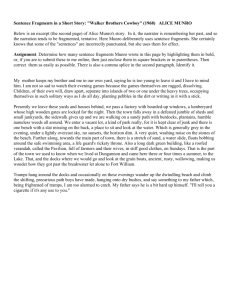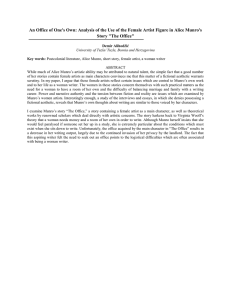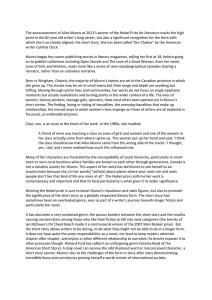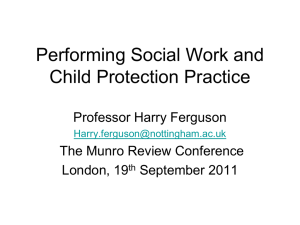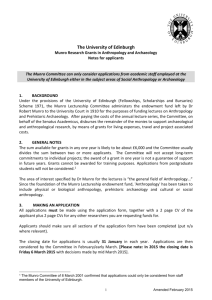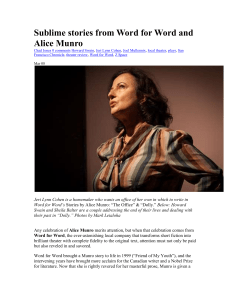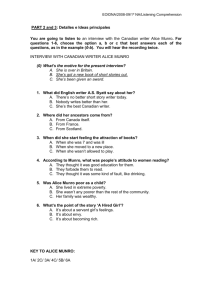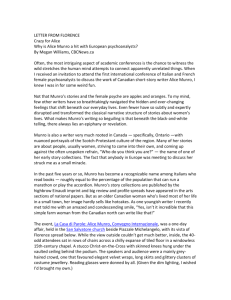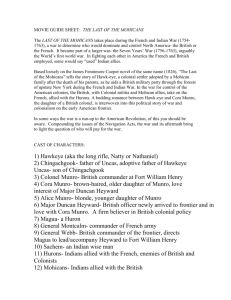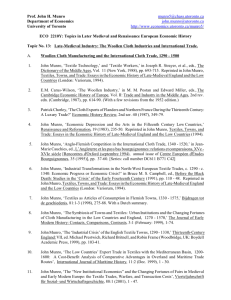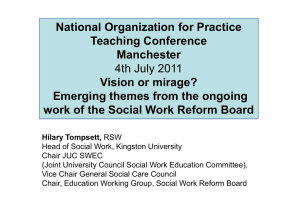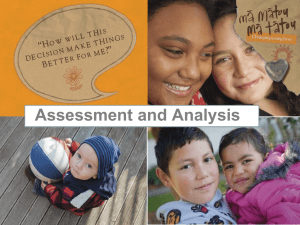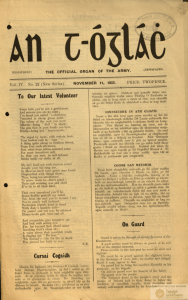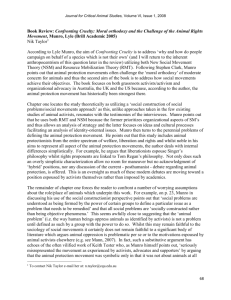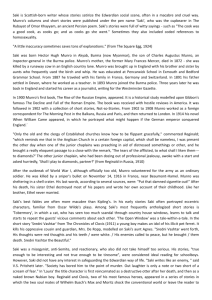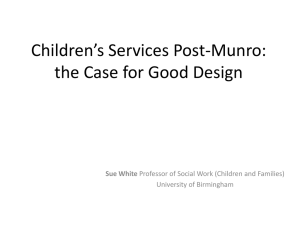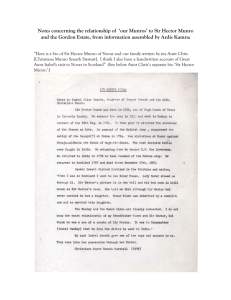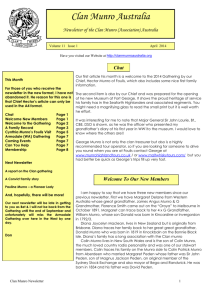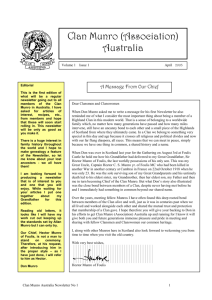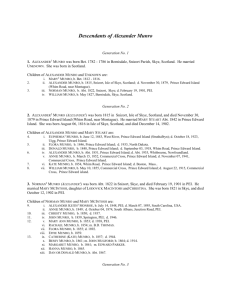Munro Review Key Messages - Staffordshire Safeguarding Children
advertisement
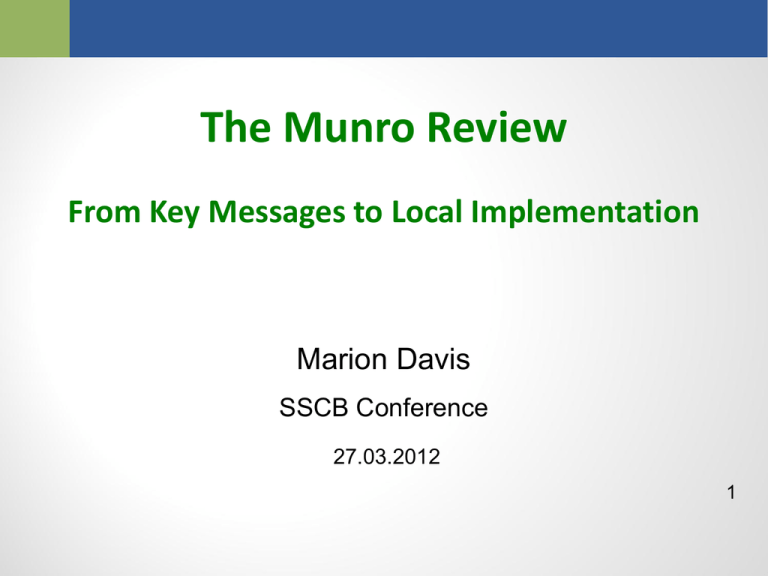
The Munro Review From Key Messages to Local Implementation Marion Davis SSCB Conference 27.03.2012 1 The Munro Review of Child Protection : Final Report. A child-centred system 2 Context : • Review commissioned by Secretary of State in June 2012 - very early in life of coalition government • Strong follow on to Social Work Task Force/ Reform Board • Access to Laming reports and documents • Link to other reviews (Allen, Tickell, Field and Family Justice Review) • NOT in response to a child death 3 Structure of the Review 8 Sub Groups • Early Help • Rules & Guidance • Children & Young People • Courts • ICT • Learning from Practice • Media & Public Confidence • Performance & Inspection 4 Munro Review 3 reports : Part 1 “A Systems Analysis” (Oct. ‘10) Part 2 “The Childs Journey” (Feb. ‘11) Final Report “A Child-Centred System” (May ‘11) 15 recommendations 5 Drivers of the system in recent years : The child protection system in recent times has been shaped by four key driving forces: • the importance of the safety and welfare of children and young people • a belief held by many that uncertainty in child protection work can be eradicated • A tendency in inquiries to focus on professional error and a tendency to blame, without examining the causes of any error • the undue weight given to performance information and targets 6 Remember…….. • The child protection system in England has good multi- agency working to protect and help children • By international comparisons England has a low level of child deaths attributable to abuse and neglect. • There is substantial research and knowledge about effective interventions, and a growing use of the evidence base by practitioners. ….. you just wouldn’t know that from the media. 7 Key Messages : • Children and young people not sufficiently seen and heard • Continuity of relationships not valued highly enough • Bureaucratic processes drive and dominate professional practice • Over-use of central prescription to improve practice, and cumulative effect is negative • The system is weighted towards responding to serious abuse and neglect with insufficient preventative, early help • There is a vital role for universal services in the provision of early help – it is a shared responsibility for all those working with children, young people and families in local areas • Some of the best places are innovating despite the rigidity around them. There is good practice to be learned from them. 8 Themed Recommendations • Valuing Professional Expertise (Recs 1, 2, 3 and 4) • Sharing responsibility for the provision of early years help (Recs 8, 10 and 13) • Developing social work expertise and supporting effective practice (Recs 11, 12, 14 and 15) • Strengthening accountabilities and creating a learning system (Recs 5, 6, 7 and 9) 9 No cherry picking! 10 If this review was fully implemented, what would it look like? • A system that learns whether children are being helped, and how they have experienced the help, innovating in response to feedback • A system free from unnecessary central prescription over professional practice but with clear rules about where and how to co-ordinate action to protect children and young people • A system where professional practice is informed by research and evidence, competent judgement informing action when the work is too varied for rules • A system that expects and recognises errors and so tries to catch them quickly • A system that is ‘risk sensible’ 11 The Government’s Initial Response (Jul. ‘11) • DfE welcomed Professor Munro’s thorough analysis. • Response was to be phased and implemented with the sector. • Ministers established an implementation working group drawing together key individuals from the social work profession, local government, health, police, education and the voluntary sector. • 9 recommendations were accepted (Recs 1, 2, 3, 4, 5, 11, 12, 13, 14) • 5 recommendations were accepted in principle (Recs 6, 7, 8, 10, 15) • 1 recommendation needed to be considered further (Rec 9) 12 Then what happened? • “Working Together” review (began Sep. ‘11) • Implementation Group convened and continues • Revision of statutory guidance on role of DCS and Lead Member • Revision of Ofsted inspection framework produced, consulted on for implementation May ‘12 (Role of other inspectorates being considered.) • Ofsted evaluation of SCRs “streamlined” • Pilots of revised SCR methodologies being undertaken • Work of 8 LAs trialling more flexible approaches to assessment extended 13 • National e-CAF decommissioned Then what happened? (continued…) • A new statutory duty to deliver early help has been deemed unnecessary (existing legislation to be clarified) • Children’s safeguarding national performance information dataset produced for consultation (Jan. – Apr. ‘12) and local performance information has been developed • Workforce reform issues in respect of child and family social work are being picked up by CWDC/SWRB and TCSW • Discussions have taken place with groups of LSCB chairs regarding strengthening of their role • “Safeguarding Children in the Reformed NHS” published and draft accountabilities framework being consulted on. A summary of progress was given to the House of Commons by Tim Loughton on 13.12.11 14 Next Steps • Eileen Munro has been asked by DfE to report on progress one year on (May ‘12) • Sector-led improvement (nationally through the Children’s Improvement Board and locally through regional arrangements) is available to support LAs in learning and developing their approach to safeguarding in the light of Munro • Individual LAs/LSCBs/regional groups are starting to implement parts of the Munro Review (but in some areas there is still a “wait and see” response) • What is needed to deliver the system change and culture shift required by the Review? 15 Local Implementation of Munro • Evidence is being gathered of excellent examples of implementation Early help Social work reform and practice developments Front door responses Engagement of universal services Listening to children and families • West Midlands regional conference has been held and collaboration between LAs agreed • LSCBs are considering their strengthened role and their links to Health and Well-Being Boards and Children’s Trusts • Implementation is taking place in a challenging context – budgetary, workload, agency changes. 16 Questions for SSCB • Are you monitoring your progress in response to Munro? • Is implementation happening as a whole systems approach (or might there be “cherry picking”)? • Are front-line workers, particularly social workers perceiving changes? • How are children, young people and families involved in change – does it feel like the focus is on the child’s journey? • How is the leadership challenge of developing a “Munro appropriate” culture across the whole system being taken forward? 17
